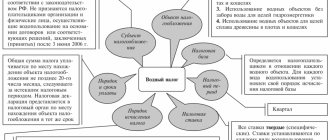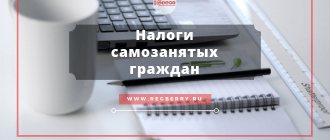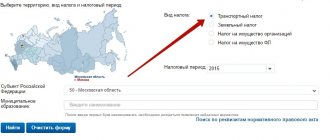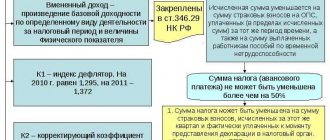Tax entry deadline
One of the reasons for introducing the new tax is the redistribution of responsibilities for collecting funds from organizations that have a negative impact on the environment.
Until 2021, the responsibility for collection fell on the relevant agency – Rosprirodnadzor. The government agency, which did not have payments as its main task, achieved less than half of the required volume of compensation for damage caused to the environment.
The transfer of responsibilities to the Federal Tax Service, which has the necessary experience in collecting debts and organizing the payment of mandatory payments, should lead to an increase in budget revenues. In theory, this will provide new resources to protect the environment. All funds collected will go into the general budget, from which money will then be allocated for environmental protection.
In addition to changes in the recipient of payments, the type of payment itself has changed: the environmental fee has become a tax. The new legislative provisions largely duplicate the content of the current federal law of January 10, 2002 No. 7-FZ (Article 16). According to the drafters, the environmental tax should maintain the status quo for organizations making payments. The changes will only affect unscrupulous enterprises that are required to make payments but do not do so. From 2021 they will be responsible to the tax authorities.
From January 1 to March 1, 2021, there will be a transition period during which Rosprirodnadzor will transmit data on organizations that have a negative impact on the environment to the Federal Tax Service. Over the next 10 years (until December 31, 2029), a reduced penalty interest rate of 10% will apply for defaulters. Changes to the Tax Code are expected to come into force on January 1, 2021.
Fee for NVOS
The need to pay for negative impacts on the environment is a legally established obligation of natural resource users.
Currently (until January 1, 2021), the list of types of negative impact for which a fee may be charged on the environment is open and includes about 10 types of possible impact on the environment as a result of economic and other activities. The corresponding listing contains Art. 16 Federal Law “On Environmental Protection”.
However, this does not mean that business entities whose activities have environmental aspects referred to in Art. 16 of the specified Federal Law, with established frequency, they are forced to regularly calculate and enter into the budget system of the Russian Federation all types of listed payments.
In fact, only three types of fees for NVOS are actually established:
- payment for emissions of harmful (pollutants) and other substances into the air;
- payment for the discharge of substances and microorganisms into a water body;
- payment for the disposal of production and consumption waste.
Note!
The process of submitting the calculation of fees for the tax assessment
First, the user of natural resources should download the current form “Calculation of fees for negative impacts on the environment” from Rostechnadzor Order No. 204 dated 04/05/2007 (as amended on 03/27/2008).
(The document can be found on the official website of Rosprirodnadzor or in “Consultant-plus”, “Garant”). Secondly, the form must be filled out in accordance with the current information of the enterprise according to the instructions “Procedure for filling out and submitting the form for calculating fees for negative environmental impact” (Appendix No. 2 Order of Rostechnadzor dated 04/05/2007 N 204 (as amended on 03/27/2008) The form consists of four sections (Fig. 1-6)
Thirdly, the form is submitted to Rosprirodnadzor (by mail or delivered personally by a representative of the organization).
Rice. 1. Cover page for calculating fees for negative environmental impact
Rice. 2. Table for calculating the amount of payment to be paid to the budget
Rice. 3. Table for calculating the amount of payment for emissions from stationary sources
Rice. 4. Table for calculating the amount of payment for emissions from mobile sources
Rice. 5. Table for calculating the amount of payment for discharges of pollutants
Rice. 6. Table for calculating the amount of payment for production and consumption waste
Such types of payment as payment for pollution of subsoil, soil, payment for physical impact on atmospheric air and the like cannot be calculated today due to:
- the absence of established rates (standards) of payment in relation to these types of negative impact on the environment;
- the absence of a mechanism for regulating the corresponding negative impact on the environment, and, consequently, the possibility of obtaining permits for the impact.
In turn, from January 1, 2021, the considered “excesses” of legal regulation will be abolished and the types of NVOS for which a fee is charged will be reduced to the three previously indicated types of fees.
Having dealt with the question “What to pay for?” it is necessary to identify the persons obligated to make the payments in question and find an answer to the question “Who should pay?”
Of course, the answer seems obvious - those who directly impact the environment pay. However, this answer is not universal for all types of fees for NVOS.
Thus, in the case of fees for emissions and discharges, the indicated general rule applies without additional reservations:
- Payments for emissions from stationary sources are calculated and paid by persons directly operating the relevant sources.
- Payments for discharges into a water body are also calculated and paid by persons directly operating the wastewater outlet(s) into the water body.
It should be noted that by default, the calculation and payment of fees for emissions of pollutants into the atmospheric air is carried out not by the owner of the stationary source, but by the person operating this source.
In other words, the existence of ownership rights to a stationary source of emissions does not in itself give rise to an obligation to pay for the NVES. In this case, the identification of the person using a stationary source of emissions as part of their economic and other activities is of decisive importance.
The exception is cases of indirect discharge of wastewater into a water body through centralized drainage systems (sewage systems).
The legislator established and repeatedly removed in time the beginning of the application of a new system of relationships for the payment of fees for the discharge of wastewater into a water body through the water supply center by a separate category of “large” subscribers.
The change in the established system of legal relations consists in transferring the obligation to pay for the discharge of wastewater into a water body from the shoulders of water supply and sewerage organizations to the shoulders of “large” subscribers (carrying out activities related to the production and processing of products and discharging more than 200 cubic meters of wastewater per day in one central sewer) in relation to the volume of discharged wastewater of the latter.
However, until now, the legislatively provided features for paying fees for the discharge of wastewater into a water body through the water supply center remain only a proclaimed mechanism that is not operational.
This is due to significant shortcomings of legal regulation, in particular the absence of a normative legal act regulating the procedure for calculating the considered “subtype” of payment for NVOS and the subsequent actual unpreparedness of all subjects of law enforcement (the administrator of the fee for NVOS represented by the Federal Service for Supervision of Natural Resources, subscribers of the Central Bank , water and wastewater services organizations) to the introduction of a new system of relations.
Payment for the disposal of production and consumption waste is a special type of payment for environmental waste due to the current contradictory practice of determining the subject of this type of payment.
Thus, in accordance with the mutually exclusive judicial arbitration practice and the practice of courts of general jurisdiction, two approaches to the issue of determining the subject of payment for waste disposal have been formed:
- pays the one who generated the waste and, while remaining the owner of the waste, sent the waste for disposal (including at facilities owned by another person);
- The one who actually disposed of the waste pays, i.e. the person operating the waste disposal facility (regardless of the ownership of the disposed waste.
It should be noted that the first approach turned out to be the most used due to the commitment of state environmental supervision authorities to it, ensuring control over the correctness of calculation and timely payment of fees for environmental impact assessment.
However, it is fair to note that the existing law enforcement discussion is relevant only until January 1, 2021, given that from this date legislative changes come into force, according to which the person obliged to pay a fee for waste disposal is the person who generated it.
Mechanism for calculating fees for tax assessments
Legal regulation of the procedure for calculating fees for NVOS at the subordinate level is carried out in accordance with the following regulatory legal acts:
- Decree of the Government of the Russian Federation of August 28, 1992 No. 632 (establishes the procedure for calculating fees for the NVOS);
- Decree of the Government of the Russian Federation of June 12, 2003 No. 344 (establishes standards (rates) of payment for types of tax assessments);
- Order of Rostechnadzor dated April 5, 2007 No. 204 (approves the form for calculating the fee for the NVOS, to be filled out when calculating the fee and submitted to the territorial body of Rosprirodnadzor, and instructions for its completion).
The procedure for bringing to administrative responsibility for failure to pay fees for environmental pollution, as well as the qualification of an administrative offense, does not depend on the specific type of payment for environmental pollution.
Evasion from the quarterly fulfillment of the corresponding obligation constitutes an administrative offense, liability for which is provided for in Art. 8.41 Code of Administrative Offenses of the Russian Federation.
Moreover, the failure of a natural resource user to pay a fee for an environmental impact assessment and his subsequent bringing him to administrative responsibility does not relieve the subject of the payment from the obligation to pay the fee at the request of the state environmental supervision body, taking into account the general statute of limitations (i.e., if a corresponding demand is presented within 3 years from the moment of non-payment).
In this case, the initial data for calculating the fee for the environmental impact assessment will be the results of primary accounting in the field of environmental protection by type of negative impact, the results of industrial environmental control, as well as information on the volume of negative impact on the environment obtained as part of state environmental supervision or administrative proceedings.
June 2015
Taxpayers of environmental tax
The main principle by which taxpayers will be determined is harm to the environment. First of all, individual entrepreneurs and organizations are subject to taxation. Another condition is that the category of the facility where the activity is carried out is taken into account. The tax applies only to the first three categories.
| Conditions | Taxpayers |
| Negative impact on the environment | Organizations, individual entrepreneurs |
| Generation of waste, except MSW | Organizations, individual entrepreneurs |
| Working with MSW | Regional operators |
| Activities at stationary facilities of categories 1-3 | Organizations, individual entrepreneurs |
| Production or import of goods and packaging that are disposed of after use | Organizations, individual entrepreneurs |
| Manufacture or import of wheeled vehicles or chassis | Organizations, individual entrepreneurs |
| Purchasing vehicles from persons who have not paid the recycling fee | Organizations, individual entrepreneurs |
For example, transportation companies using trucks are not taxed because the vehicle is not a stationary source of emissions.
Each taxable person is required to register with the local tax office within 30 days of registration with the state. Within 10 days, Rosprirodnadzor transmits to the Federal Tax Service information on new facilities that negatively affect the environment. The accounting breakdown is as follows:
- Rosprirodnadzor takes into account objects;
- Federal Tax Service - taxpayers.
For activities falling into category 4, it is necessary to obtain appropriate confirmation. The total number of objects in Russia that have a negative impact on the environment is more than 250 thousand.
How to pay less environmental tax?
Those who do not keep separate records of waste generation, for them the amount of tax will be determined based on the maximum tax rate and a single tax base determined for the entire volume of waste generation.
For those territories and objects that are under special protection, an additional coefficient of 2 is provided.
Clause 4 of the article “Tax Rates” presents the applicable coefficients from 0 to 100. Taxpayers are required to develop an environmental action plan or a program to improve environmental efficiency. If, after 6 months, the indicators outlined by the plan and program are not achieved, then the rate for this taxpayer is increased by a factor of 100.
How to optimize tax expenses?
Find out about this at the one-day educational seminar “Tax Optimization” + additional advanced training course with the issuance of a certificate.
The seminar is conducted by Ekaterina Vladimirovna Shestakova, Candidate of Legal Sciences. It will take place on October 2, 2021, starting at 10 a.m. Moscow time. Participation format:
- In-person on the territory of CHTA at the address: Moscow, st. Gazetny lane, building 3-5, st. Okhotny Ryad metro station (300 meters from Red Square),
- Webinar (online) for residents of Russian regions with broadcast of the seminar on the Internet.
Get personal advice from an expert in optimizing tax schemes, who has helped win several dozen court cases against the Tax Service.
For details about the educational course, see the official event page (go to page)
Objects of taxation
Activities that are negative for the environment are identified as objects of taxation.
are not subject to environmental tax :
- activities financed from the budget of any level;
- objects that do not have a negative effect on the environment;
- packaging and reusable products;
- export goods produced on the territory of the Russian Federation;
- use of rocks and ferrous metal production waste (hazard class 4-5) to fill cavities during reclamation;
- accumulation of raw materials for subsequent disposal or disinfection within 11 months after appearance;
- Category 4 emissions at the facility;
- old vehicles (more than 30 years old) while maintaining their original condition.
Other production activities of the enterprise are taxed if they have a negative impact:
- atmospheric emissions from stationary sources;
- discharge to wastewater;
- processing of waste of any hazard class.
In addition to activities, objects act as objects:
- waste goods and packaging;
- transport packaging (used for packaging several units);
- vehicles according to the list.
How will filling out the declaration change?
The commented resolution clarifies the procedure for drawing up a declaration. According to the changes, when filling out reports, goods that are exported from the Russian Federation, as well as the packaging of such goods, are not taken into account.
In addition, it is stipulated that manufacturers of goods submit a declaration regarding:
- goods produced on the territory of the Russian Federation;
- packaging of goods produced in the Russian Federation.
Importers report on:
- goods imported from EAEU member states;
- goods imported from third countries to the Russian Federation and undergone appropriate customs operations;
- packaging of goods imported from EAEU member states;
- packaging of goods imported from third countries to the Russian Federation and undergone appropriate customs operations.
In this case, reusable packaging of goods is declared as a product.
Manufacturers include in the declaration information on the quantity of goods (packaging of goods) on the basis of primary accounting documents, shipping documents, and importers - on the basis of customs documents and shipping documents. The quantity of goods, packaging of goods is indicated for each name of product, packaging of goods in kilograms with an accuracy of one kilogram.
The tax base
When calculating the tax value, several indicators related to volume and mass are used as a base:
- atmospheric emissions;
- dumping into water;
- disposed waste.
Additional characteristics can raise or lower the final indicator:
- waste recycling (reduces);
- exceeding the standards established by Rosprirodnadzor (increases).
All types of waste processed and generated at the enterprise are taken into account. Data is collected from each stationary source based on the results of environmental monitoring at the enterprise. All values used are based on the contractual relations of the organization itself, which enters into agreements for the removal and disposal of waste.
Tax rate
The tax rate is different for each type of waste or raw material.
For loose goods, the calculation is based on each ton; for piece goods, per unit. In addition, the specifics of the product determine the use of coefficients.
Specific characteristics include some vehicle data, for example:
- year of issue;
- engine power;
- number of axes.
For each product or package, the tax rate will be similar to the current environmental fee. The size consists of 4 characteristics:
- the mass of goods sold in Russia during the year;
- coefficient;
- mass of reused goods;
- bid.
Rate value for some products:
| Product or waste | Bet size, rub. |
| Self-propelled vehicles and trailers | 172 500 |
| Other modes of transport | 150 000 |
| Lead acid batteries | 27 320 |
| Wheeled vehicles (category M1, G) | 20 000 |
| Chlorine | 181,6 |
| Nitrogen dioxide, sodium carbonate, ammonia | 138,8 |
Rules for calculating charges
Each taxpayer calculates the amount of environmental tax independently, taking into account each source of negative impact on the environment, hazard classes, and activities of hazard categories 1-3. A year after the law comes into force, a coefficient reflecting changes in consumer prices will begin to be applied.
To motivate to reduce emissions and waste generation, appropriate increasing factors will be applied:
| Meaning | Condition of use |
| 100 | Exceeding the established weight, lack of results from the emission reduction program |
| 25 | Within the limits of the temporarily permitted excess |
To calculate the tax, a formula similar to calculating the size of the environmental fee is used:
C = K * M * N, where
C – amount of tax or fee,
K – coefficient,
M – mass for disposal minus processed raw materials,
N – normal.
Reducing the payment amount
Coefficients are used as a punishment for exceeding standards, as well as as an incentive for enterprises using innovative waste treatment methods.
The key condition for using a reduction factor is that innovations must reduce the negative impact or reduce the volume of destroyed waste. For example, if waste of hazard class 3 after processing became less hazardous class 4, then such work is encouraged by a reduction in the payment amount.
Several values are used to reduce the payment as much as possible up to 70%:
| Meaning | Condition of use |
| 0,3 | When working on your own territory and not exceeding limits |
| 0,33 | Disposal of class 4 waste generated during the processing of class 2 waste |
| 0,49 | Disposal of class 4 waste generated during the processing of class 3 waste |
| 0,5 | Disposal of class 4-5 waste generated during processing of waste from the processing and mining industries |
| 0,67 | Disposal of class 3 waste generated during the processing of class 2 waste |
When introducing the best technologies paid for by the enterprise in the field of environmental protection, a zero coefficient can be applied, which resets the entire tax amount. Situations in which an enterprise may not legally pay environmental tax:
- achieving standards after the introduction of technologies at a facility that has a negative impact on the environment;
- the accumulated waste is reused for our own needs or transferred to another organization for this purpose.
How is the amount of environmental payments calculated for a specific enterprise?
Environmental payments in 2021
– this is compensation paid by enterprises only for the following types of impact:
- discharge of substances that negatively affect the ecological situation of the area into surface water bodies;
- atmospheric emissions that pollute the air;
- disposal of hazardous waste from the production of a particular product, as well as its consumption.
An important factor that is of great importance when calculating an enterprise’s environmental payments is the availability of the following documentation:
- project of maximum permissible discharges of pollutants;
- draft limits on waste generation and disposal;
- project on emissions of pollutants into atmospheric air.
The presence of these documents indicates that the company operates in full compliance with current legislation, strives by all means to reduce the negative impact on the environment and is ready to pay environmental fees in the required amount.
If the organization does not register maximum allowance and VAT, the fee for the negative impact on the environment will be 25 times more than with the presence of these projects. The absence of draft standards for waste generation and disposal will increase environmental fines fivefold.
How to reduce the amount of environmental payments and avoid large penalties?
Eco-payments for negative impacts on the environment can be very high, which will make the operation of the enterprise unprofitable. In addition, companies that avoid paying such compensation are subject to very large fines for environmental violations. Moreover, you can be subject to similar sanctions for incorrect execution of certain documents.
That is why we strongly recommend contacting our company, which:
- will develop draft standards for harmful emissions, discharges of pollutants into water bodies and waste disposal in full compliance with current legislation. This will minimize payments to environmental funds;
- will make a competent calculation of eco-payments in order to completely eliminate overpayment on them;
- will provide an opportunity to avoid fines from the environmental police.
What determines the size of environmental payments?
Our specialists have extensive experience in this type of activity, they are well aware of all types of environmental payments, as well as the criteria by which they are calculated:
- volume and type of fuel used by the enterprise in mobile sources of pollution;
- a list of hazardous and harmful substances that are discharged into surface water bodies, as well as their quantity during the reporting period;
- volume and hazard class of production waste disposed by the company;
- volume of emissions of harmful substances into the atmospheric air and their chemical composition.
We also know very well what the fines are for violating environmental laws, so we can help you avoid such sanctions on absolutely legal grounds.
Procedure and deadline for tax payment
Data for 1 calendar year are used as the taxation period.
All calculations must be made before March 25 of the following reporting year. A scheme of advance payments is used, which are accepted after the reporting period: 1-3 quarters of the year. New taxpayers begin making payments on January 1 of the following year after registering with the Federal Tax Service.
An advance scheme is used to pay the environmental tax, except for small and medium-sized businesses. In total, the payment consists of 4 parts:
- 3 advance payments equal to a quarter of the amount for last year - for the first 3 quarters;
- payment of the balance.
The final payment deadline is no later than March 25 of the year following the reporting year. Quarterly payments are paid no later than the 20th day of the first month of the next quarter.
Environmental tax: who should pay, when and how much?
The issue of non-tax payments, their quantity, and the quality of administration has been discussed in the country for a long time. In the end, the authorities decided to convert part of these payments into tax payments. The purpose of the changes is, among other things, to transfer the functions of collecting payments to the Federal Tax Service and, as a result, increase tax collection. “An analysis of the dynamics of receipts of fees for negative environmental impacts into the budget system indicates the low efficiency of its collection, which creates the need to finance state environmental programs from other revenues of the federal and regional budgets,” says the explanatory note to the bill.
Tell us in more detail what kind of project to introduce an environmental tax you are talking about.
The Ministry of Finance is considering amendments to the Tax Code regarding the creation of a new tax - environmental. The project is being prepared on behalf of Russian Prime Minister Dmitry Medvedev dated March 16, 2021 No. DM-P13-10. The Financial Department proposes to introduce a new chapter in parts 1 and 2 of the Tax Code. Public discussion of the project ended on August 31, 2021.
In essence, the new tax is the implementation of the authorities’ plan to transfer part of non-tax payments to tax payments. This is true?
Absolutely right. It is planned to replace the fee for negative environmental impact (NEI). As part of the systematization of non-tax payments, the Ministry of Finance streamlines payments that do not have signs of tax. The environmental fee currently being paid should gradually “transform” into an environmental tax from 2021. The Ministry of Finance wants to streamline non-tax payments and tighten measures for their non-payment. The environmental tax does not provide for an increase in the tax burden.
Will the fee rates change or remain the same?
Objects of taxation, payment rates, payment procedures and terms will remain the same. But the payment regime will be tightened. Officials say that for conscientious payers the fiscal burden will not change. Entrepreneurs will calculate the base themselves for each taxable object, and the rates will be calculated by type of pollutant and hazard class of production and consumption waste.
Tax rates are divided into groups:
- for emissions of pollutants into the air from stationary sources;
- for discharges of pollutants into water bodies;
- for the disposal of production and consumption waste according to their hazard class.
The rate will be calculated based on 1 ton of pollutants (production and consumption waste).
note
Objects of taxation, payment rates, payment procedures and terms will remain the same. But the payment regime will be tightened. Officials say that for conscientious payers the fiscal burden will not change. Entrepreneurs will calculate the base themselves for each taxable object, and the rates will be calculated by type of pollutant and hazard class of production and consumption waste.
From 2021, the authorities will introduce coefficients to encourage emissions reduction. The highest coefficient of 100 will be applied for exceeding the established volumes or mass of harmful emissions. Conversely, the tax amount can be reduced if there were expenses associated with the implementation of measures to reduce the negative impact on the environment.
Will the number of companies required to pay environmental taxes increase or decrease?
Tax payers remain organizations and individuals, individual entrepreneurs whose activities have a negative impact on the environment.
It is difficult to estimate the change in the number of companies required to pay this tax. The difficulty of assessment is related to market development and the emergence of new technologies by 2021. Currently, manufacturers and importers of goods that need to be disposed of after losing their consumer properties are required to pay the fee. Manufacturers and importers who independently ensure waste disposal are exempt from paying the fee. Of course, we would like to reduce the number of companies that will pay environmental taxes. After all, no amount of money will ensure the preservation of good ecology in the country.
Will the payee change?
Will change. Now the NVOS is paid to Rosprirodnadzor. The payment is transferred according to the details of the relevant territorial body of Rosprirodnadzor, at the location of which a stationary source of emissions (discharges) is located, a mobile object of negative impact is registered, or a waste disposal facility is located. In the future, environmental tax payers will need to register with the Federal Tax Service and pay the fee there. In this case, not only the recipient’s details will change, but also the payment BCC.
Will the tax payment procedure change?
The fee for negative impact on the environment and the environmental tax are the same. The new law does not provide for changes. The reporting period for payment of the negative impact fee and environmental tax remains the calendar year. Quarterly advance payments will also be paid; The total amount of the fee must be transferred to the budget at the end of the year. Quarterly advance payments are made by all payers (except for small and medium-sized businesses). Deadline – no later than the 20th day of the month following the reporting quarter. The advance payment for each quarter is equal to 1/4 of the payment amount for the previous year. The amount of the surcharge at the end of the year can be determined as the difference between the amount of fees accrued for the year and the amount of advance payments transferred to the budget during the year.
Submitted reporting
Filling out a tax return occurs only electronically. The taxpayer provides and takes into account the following data:
- volume and class of waste for each source;
- bet and odds.
The first indicator is determined through environmental control, as well as on the basis of acts of acceptance and transfer of waste for disposal to third parties. All provided data related to waste management must be confirmed by the regulatory authority - Rosprirodnadzor. When filling out the electronic form, indicate the place of filing the declaration - the local branch of the Federal Tax Service.
Procedure for filling out the declaration
The form is not completed for exported goods and packages. Goods and packaging produced in Russia, EAEU countries, and third countries are included in the declaration (after completing customs procedures).
The declaration of manufacturers is filled out on the basis of accounting documents, importers - customs and transport. Each name and each unit of goods is taken into account, as well as weight with a discrepancy from the actual one of no more than a kilogram.







